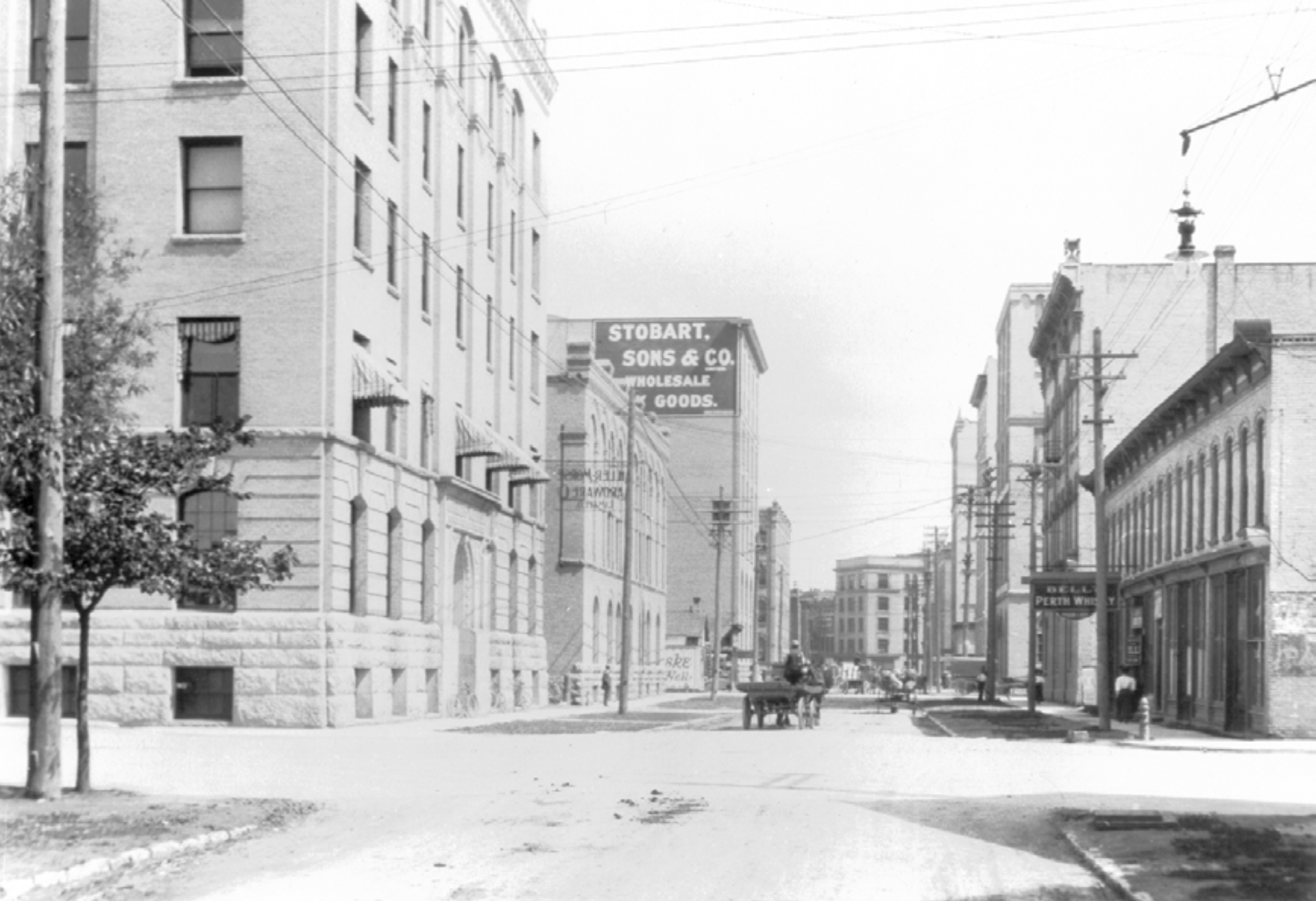
No.26
Stobart Sons & Co.

Location: Winnipeg, MB
Date illuminated: July 29, 2017
Permanent launch: June 17, 2022
Layers: 3
Visit the other permanent Winnipeg installation:
Location & Viewing Hours
On display nightly: Sunset - 12 AM
Generously Supported by:

Layered History
This is a palimpsest - a ghost sign showing multiple worn ads painted on each other. This specific sign - nicknamed 'Stobart' - has three discernable layers we were able to revive. Learn more below about the business and brands that called this building home.

Layer 1 — Painted in 1907
Stobart, Sons & Company


Layer 2 — Painted in 1915
Christie Grant Mail Order


Layer 3 — Painted in 1922
Barber-Ellis Envelope Manufacturers


Layer 1
Painted 1907
Stobart, Sons and Company
William Stobart was an English coal merchant who came to Canada to make his fortune as a fur trader. He traveled extensively throughout western Canada in the 1860s, making the trip across the Atlantic ocean more than 25 times to get goods to and from the United Kingdom.
In 1874, Stobart partnered with merchant F.E. Kew to create Kew and Stobart on the east side of Main Street in Winnipeg’s downtown. The business operated out of Winnipeg, Manitoba and 28 Fenchurch Street in London, England until 1876, when Kew withdrew from the business.
Shortly after, the company underwent a reorganisation, changed its name to Stobart, Eden and Company and started construction on a new wholesale and dry goods warehouse and retail storefront on Portage Avenue. In 1880, William Stobart’s son Fred Stobart relocated from England at the age of 21 and joined the company in Winnipeg. In 1899, after William Stobart’s death, the business was incorporated as Stobart, Sons and company, with the majority of stock held by Fred Stobart and his brothers.
The wholesale and dry goods business quickly outgrew its Portage Avenue location, and in 1903, constructed 281 McDermot Avenue as its head office. The same year, Stobart branched out from wholesale and moved into manufacturing, trademarking “No. 1 Hard” and selling their own brand of overalls and work shirts. With the growth of the business, 281 McDermot Avenue added two more floors to the five-storey building in 1907, with the Stobart, Sons and Company sign painted on both the north and west sides of the addition.

c. 1910. Credit: M. Peterson Collection



Layer 2
Painted in 1915
Christie Grant Mail Order
The Christie Grant Company Limited was established in May 1914, one month before the start of the First World War. By December of that year, they had secured warehouse space at 110 Princess Street in Winnipeg and started advertising for young men with mail-order experience and women with neat and rapid handwriting for addressing parcels. The business quickly became profitable, but the outbreak of the war caused concerns for the company directors that they lacked the capital to expand the enterprise.
The wholesale operation run by Stobart became a logical purchase partner and in 1915, Stobart, Sons and Company acquired the business and changed its name to Christie Grant Mail Order. All staff was retained, but they moved offices to 281 McDermot Avenue. Unfortunately, the influx of working capital wasn’t a match against the war and the Christie Grant company became one of the worst Canadian commercial crashes of its day.
Under the strain of shrinking business and falling prices, they sustained heavy financial losses and in March 1921, the company declared bankruptcy, with locations in Winnipeg, Manitoba, Medicine Hat, Alberta and Saskatoon, Saskatchewan shutting their doors in 1921.
Layer 3
Painted 1922
Barber-Ellis Envelope Manufacturers
In 1922, the building was taken over by Barber-Ellis, an envelope and stationery manufacturer from Toronto, Ontario. Founded in 1876 by John Barber and John Ellis, the company quickly grew to be the largest envelope manufacturer in the nation, with factories and offices in 10 Canadian cities. When Barber-Ellis took over 281 McDermot Avenue as a manufacturing facility, they had over 500 employees from coast to coast. In the 1980s, the company ceased operations in Winnipeg and 1992, the company was acquired by Unisource.
c. 1926. Credit: 1986 Report of the City of Winnipeg Historic Buildings Committee
About the collaborators

Craig Winslow
Light Artist & Experiential Director
Craig Winslow is an artist and designer who employs light to create playful, narrative-driven visualizations and immersive experiences. He was awarded a creative residency by Adobe in 2016, during which he started Light Capsules. Since then, he has continued this augmented restoration project to revive faded hand-painted ads around the world. His permanent exhibition 'Brilliant!' launched in Las Vegas in 2018 at The Neon Museum, and was expanded upon in 2021.

Matt Cohen
Urban Archaeologist, Founder ghostsigns.ca
Matt Cohen is a brand strategist, urban archaeologist, and the driving force behind ghostsigns.ca. Since 2013, he's been documenting Winnipeg's collection of fading ads, leading downtown walking tours, and delivering promotional signage presentations. In 2021, he published Canada’s first ghost sign walking tour book.
Press:
Additional Viewing:
Writing On The Wall – Documentary
Rosco Spectrum Blog Feature
Inquiries:
Light Capsules™ © Winslow Studio, LLC





